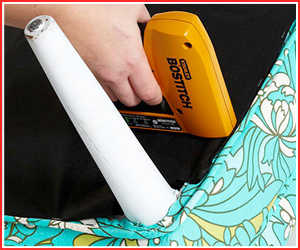 Often our upholstery foams are purchased to complete home staple-down projects. This can be the case for kitchen chairs, bar stools, and certain style benches, among a variety of other projects. These types of projects require a couple tips to keep in mind when starting a staple-down project:
Often our upholstery foams are purchased to complete home staple-down projects. This can be the case for kitchen chairs, bar stools, and certain style benches, among a variety of other projects. These types of projects require a couple tips to keep in mind when starting a staple-down project:
Understanding staple-down upholstery
The three most popular styles in staple-down upholstery are:
- Contoured – this style creates a completely rounded edge from top to bottom, achieved by pulling firmly down on the fabric and wrapping it under the wood when stapling. This action will pull the foam down tight to the edge of the wood.
- Waterfall – this style creates a rounded top corner, transitioning to a straight downward drop to the wood panel. It’s achieved by pulling moderately tight on the fabric, enough to round the edge but not enough to compress the foam. The fabric is then stapled underneath.
- Straight edged – this is the least common of the three styles, achieved by pulling the fabric underneath the wood, tight enough to remove any wrinkles, but not tight enough to compress the foam. The fabric is then stapled to the wood. In this style, it’s very common for the fabric to have the corners sewn to a fitted shape prior to stapling the fabric to the wood.
Choosing the right foam
With staple-down projects, your foam selection is usually directly linked to the style you’re hoping to achieve. Thinner foams (1 to 2 inches) are most commonly used to achieve a contoured final look, while thicker foams (2 to 4inches) are commonly used for waterfall or straight edged looks. Of course we have you covered with plenty of foams (and thicknesses) to choose from.
Cutting the foam
In most cases, the foam is cut either directly to the size of the wooden template, or at most just 1/8th of an inch larger. This is because in most cases, the wooden seat sits flush into the frame of the chair.
If your seat sits on top of the frame of the chair, and you are choosing a contoured style, be sure to cut your foam ½ inch larger than the wood to create a soft foam edge on the seat. Make sure you check out our cutting tips in order to do this safely.
Help is close by
If you find yourself stuck in the stuffing stage, stop by and get direction and advice from our helpful staff at a convenient location near you
